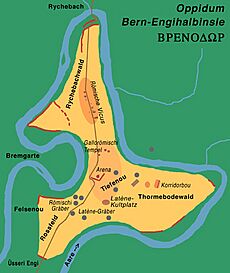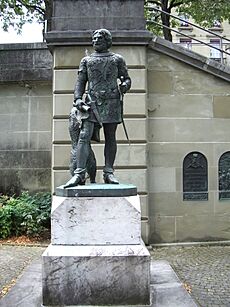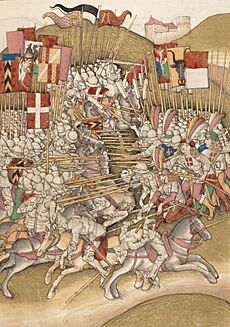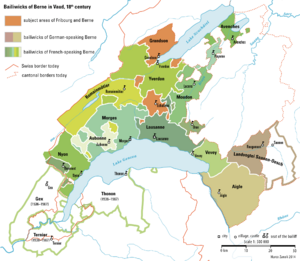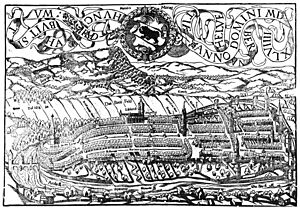History of Bern facts for kids
The city of Bern was founded in the late 1100s by the Zähringer family. The official founding date is 1191. By the end of the 1200s, Bern became almost like an independent city. It was directly under the Holy Roman Emperor, not a local lord.
In 1353, Bern joined the Old Swiss Confederacy, a group of independent states. During the 1400s, Bern grew a lot. It took over new lands, like Aargau in 1415. When it gained Vaud in 1536, Bern became the strongest city-republic (a city that acts like its own country) north of the Alps. It was also a leading Protestant city in early modern Switzerland.
After 1815, even after losing Aargau and Vaud, the canton of Bern was still the largest Swiss canton. It became second largest only when Jura separated in 1979. Since 1848, Bern has been the federal city (capital) of Switzerland.
Contents
What's in a Name?
The exact origin of the name Bern is not fully known. A local story says that Berchtold V, Duke of Zähringen, who founded the city, promised to name it after the first animal he saw while hunting. This animal was a bear, so the city got its name and its symbol.
However, the link between Bern and the German word for bear, Bär, is likely just a popular story, not the real reason. Many people think the city was named after Verona, an Italian city. Verona was known as Bern in German during the Middle Ages.
In the 1980s, a metal tablet called the Bern zinc tablet was found. It showed that an older Celtic name, Brenodor, might have been used for the area in Roman times. This made some people think that Bern might be a changed version of this older Celtic name. The Celtic word might be related to a word meaning 'gap' or 'chasm'.
Later, in the Middle Ages, Bern became strongly linked to its bear symbol. Bears were used to show the military power of the canton. Bernese soldiers were even shown as armed bears. From the 1500s, people also called them mötz or motzlin, which meant "bear" in a local dialect. This word became Mutz in modern times. In the 1800s, Mutz was used for the city or canton itself. People even jokingly called Bern Mutzopolis.
Bern's Early Days
The first signs of people living in the Aare valley go back to the Neolithic period (New Stone Age). But the earliest known settlement in the Bern area was on the Engehalbinsel peninsula. This was north of where the city is now. This settlement was from the late La Tène culture (around 300 to 200 BCE). It was fortified in the 100s BCE. It might have been one of the twelve large fortified settlements, called oppida, of the Helvetii people mentioned by Julius Caesar.
There were also other La Tène settlements nearby. These were in areas like Breitenrain, Kirchenfeld, Mattenhof, and at Bümpliz. Bümpliz is now part of Bern, about 4 km (2.5 mi) from the old city.
After the Romans took over, a small Roman settlement, called a vicus, was built in the same spot. South of the vicus was a burial ground with over 160 graves. Some of these were from the La Tène period. The vicus had a small amphitheater, a temple area, and private homes with workshops. At its northern end, there was a bathing facility. The main road from the vicus led west to Aventicum. The vicus on Engehalbinsel was left empty between 165 and 211 CE.
Even after the Roman Empire fell, some people still lived in the area around Bern. A large graveyard with over 300 graves was used in the 500s and 600s. This was on the edge of the Bremgarten woods. Other graveyards from the 600s were found in Weissenbühl and on Rosenbühl hill. In the Early Middle Ages, there was a settlement with a church in Bümpliz from the 600s to 900s. In the 800s or 900s, a Burgundian royal court (Königshof) with wooden defenses was built near this settlement. However, no old remains have been found yet on the site of today's old town that are older than the 1100s.
Bern's Medieval Founding
The true history of Bern began when Berthold V, Duke of Zähringen, founded the city. This happened in the late 1100s, with 1191 being the official date. At that time, much of what is now western Switzerland was ruled by the house of Zähringen. The Zähringer leaders were called dukes by the German king. They had imperial power south of the Rhine River. To strengthen their position, they founded or expanded many settlements. These included Fribourg (in 1157), Bern, Burgdorf, and Morat.
In the second half of the 1100s, Berchtold V built a small castle at Nydegg. This was on the eastern part of the peninsula. It was meant to guard the Aare River. The castle was on the border between German-speaking and French-speaking areas. It is debated if a settlement was already there or if the town was founded near the castle in 1191. The first city was built west along the narrow peninsula. It had three main streets running from east to west. The city's design and the church's location were typical for Zähringer cities.
After Berchtold V died without children, Bern gained its town privileges. It became an Imperial Free City with the Goldene Handfeste. This document is traditionally dated to 1218. It was supposedly from Emperor Frederick II. But most experts now believe it was a fake document made by Bern in the mid-1200s. However, on January 16, 1274, King Rudolph I of Germany confirmed the rights in the Goldene Handfeste.
At first, the city was led by a mayor. This mayor came from one of the noble families who were citizens of Bern. The Zähringens appointed the mayor at first. Then the Holy Roman Emperor or his representative did. But by the late 1200s, the town council elected the mayor. By the end of the 1200s, Bern was practically an independent city-state within the Holy Roman Empire.
Joining the Swiss Confederacy
In 1293, King Adolf of Germany confirmed all the special rights Bern had gained. Even though these rights were still given by a king, Bern started acting like an independent imperial city after 1300. It began to expand its territory.
In 1323, Bern formed an alliance with the Forest Cantons of Uri, Schwyz, and Unterwalden. As Bern continued to grow in the early 1300s, it clashed with feudal lords supported by Burgundy and Habsburg families. It also fought with the nearby city of Fribourg. In 1339, these feudal lords and Fribourg gathered a force of 17,000 men. This included 1,000 heavy cavalry.
Bern asked its Swiss Confederation allies for help. It raised 6,000 soldiers from Bern, Uri, Schwyz, Unterwalden, and other allies. When the Fribourg forces attacked the Bernese border town of Laupen, the Bernese army marched out. Even though they were outnumbered two to one, the Bernese soldiers formed strong pike formations. These destroyed the Fribourg infantry and heavy cavalry. This big Bernese victory helped Bern become stronger. It also brought them closer to the Forest Cantons.
In 1353, Bern made its agreement with the Forest Cantons a permanent alliance. This made Bern a full member of the Old Swiss Confederacy. With Bern joining, the confederacy now had eight cantons (Acht Orte). This completed its early formation. Bern became a leading member of the Confederacy. It strongly encouraged the expansion policy that continued through the late 1300s and 1400s.
How the City-State Grew
Bern attacked and took over Aargau in 1415 and Vaud in 1536. It also gained other smaller areas. By the 1700s, Bern had become the largest city-state north of the Alps. It controlled most of what is now the canton of Bern and the canton of Vaud.
Bern's expansion also led it into the Bernese Oberland. Through battles, purchases, or marriages, Bern gained most of the Oberland from local barons between 1323 and 1400. Under Bern's rule, the five valleys of Oberland had many rights and a lot of freedom. This was especially true for the farming communities (Bäuert) and rural alpine communities (Talverbänden).
However, the Oberland revolted several times against Bern's rule. In 1445, the Evil League (Böser Bund) fought against Bernese military service and taxes. This happened after the Old Zürich War. In 1528, the Oberland rebelled against the Protestant Reformation. In 1641, Thun also revolted.
How the City Developed
When Bern was founded, it probably had about 400 to 600 people. This grew to 3,000 by about 1300. During the city's fast growth in the 1200s, the old Nydegg castle was torn down. The slopes along the Aare River were fortified. The layout of today's Old Town was created. Strong defenses, called Neustadt fortifications, closed off the peninsula. These limited the city's growth until the 1800s.
The city grew towards the west of the peninsula. At first, the Zytglogge tower marked the city's western edge from 1191 to 1256. Then the Käfigturm took over this role until 1345. After that, the Christoffelturm (near today's train station) was the boundary until 1622. During the Thirty Years' War, two new defenses were built. These were called the big and small Schanze (entrenchment). They protected the whole peninsula.
After a big fire in 1405, the original wooden buildings were slowly replaced. First came half-timbered houses, then the sandstone buildings. These sandstone buildings became a key feature of the Old Town. Even with waves of plague in the 1300s, the city kept growing. This was mainly because people moved in from the countryside.
Bern was not on any major trade routes. So, agriculture quickly became very important for its economy. It stayed important throughout Bern's history. Tannery (making leather) also became a big industry. Leather goods were one of Bern's main exports. In the 1300s, as European trade grew, many rich trading families became the city's upper class. However, in the 1400s, they mostly turned to government and mercenary (soldier for hire) service. Trade slowed down as the city's strict rule over the countryside grew stronger. Bernese trade and crafts, organized in guilds, thrived in the 1500s and 1600s. Bernese glass paintings were especially popular across Europe.
Society and How Bern Was Ruled
Bern's traditional way of governing, set up in 1294, stayed mostly the same until 1798. It had a Grosser Rat (Grand Council) with 200 members. It also had a Kleiner Rat (Small Council) with 27 members. The Small Council included the Schultheiss (mayor), who was the main leader. It also had other public officials like guild representatives, the city clerk (Stadtschreiber), the treasurer (Seckelmeister), and the Grand Bailiff (Grossweibel).
In the Middle Ages, it was fairly easy for successful traders and craftspeople to gain power. But as Bern grew in power and wealth, its society became more divided. By the 1600s, being a citizen was something you inherited. All political groups chose each other. Officials were elected for life.
Bern now called itself a Republic (Stadt und Republik Bern). It followed the example of the Italian city republics. In reality, public offices were only for the gnädige Herren, or "merciful lords." This was the name for the small number of noble families who now ruled Bern. In 1605, 152 families could rule. By 1691, that number was only 104. By the late 1700s, there were only 69 such families. Meanwhile, the land ruled by the city grew. Eventually, Bern governed 52 areas called bailiwicks. These government jobs became very profitable as Bern's territories grew. The noble Landvögte, or sheriffs, ruled the countryside. They often used armed force to stop peasant revolts.
In 1528, after three weeks of discussions (from January 6 to 26, known as the Bern Disputation), Bern became Protestant.
Bern in Modern Times
In 1798, Bern was taken over by French troops during the French Revolutionary Wars. It lost some of its territories. The Bernese Oberland was separated to become the Canton of Oberland. In this new canton, old borders and traditional rights were ignored. Since the people there were conservative and had no desire to separate, they were not happy with the new changes. The 1801 Malmaison Constitution suggested putting Oberland back with Bern. But it wasn't until the Act of Mediation two years later, when the Helvetic Republic was ended, that the two cantons were reunited.
After the Congress of Vienna in 1814, Bern gained the Bernese Jura. This made it the largest canton in the confederacy again. It remained the largest until the canton of Jura separated in 1979. In 1848, Bern was made the Federal City (the place where the Federal Assembly meets) of the new Swiss federal state.
Many meetings of the socialist First and Second Internationals were held in Bern. This was especially true during World War I, when Switzerland remained neutral.
The city's population grew a lot. It went from about 5,000 people in the 1400s to about 12,000 by 1800. By 1900, it was over 60,000. It passed 100,000 in the 1920s. The population reached its highest point in the 1960s with 165,000 people. Since then, it has gone down slightly. By 2000, it was below 130,000. As of December 31, 2009, Bern had 130,289 residents. Of these, 101,627 were Swiss citizens and 28,662 (22%) were foreign residents. Another estimated 350,000 people live in the surrounding city area.
See also
- Timeline of Bern
- Swiss peasant war of 1653
- History of the Jews in Bern



